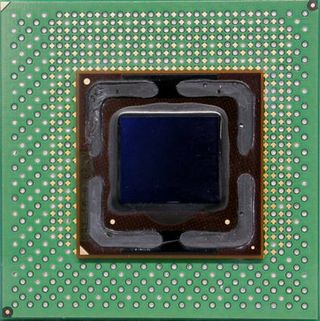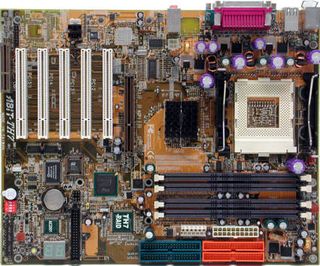The Mother of All CPU Charts Part 1
Socket 423: November 2000 To August 2001
| Pentium 4/1300 to 2000: | November 2000 to August 2001 |
Experiencing a similarly short life span as Slot 1 in 1997 was Socket 423, which was used from November 2000 to August 2001. For most users the later switch to Socket 478 meant more frustration, because their investment came to nothing. For Socket 423 there was one single CPU core, the Willamette. The sales figures were far below expectations, but the share price of Intel rose. The introduction of the Intel Pentium 4 and the Netburst architecture meant a big step into the future. Even the current Pentium 4 570 with 3.8 GHz still relies on this architecture, which impressively shows the scaling of the clock speed. The clock speed is also what counts with this processor and what Intel has been pushing for years. At the same time, throttling technology (Thermal Monitor 1) came into use. This technology caused the CPU to skip clock cycles and protect itself from dying of heat whenever cooling was inadequate. Read about it and download the video here: Hot Spot: How Modern Processors Cope With Heat Emergencies .
As the clock speed and the number of transistors rose, so did heat loss. To meet the enormous power demand, motherboards were equipped with additional electrical connections, because the P4 had reached heat loss of up to 72 watts. Numerous technical innovations came along with this: SSE2 allowed fast video encoding and became a strength as well as a selling point for this processor. However, this made applications necessary that would also use the SSE2 expansions. Because of this step, upgrading from an older system was no longer easily possible: In addition to a new board, you needed a power supply, a CPU cooler and Rambus memory. Intel reached record levels with the 850 chipset (Tehama) including the RD800 dual-channel by achieving memory bandwidth of up to 2.5 GB/s. But the prices for such systems were too high, particularly due to the memory, and did not meet with approval in the market. There were also license fees levied by Rambus on the manufacturers. For contractual reasons, Intel was not allowed to offer any DDR memory in connection with the Pentium 4. And at the same time there was DDR-SDRAM!

The Intel Pentium 4 for Socket 423 had a thermal loss of 72.4 watts and was the first CPU to have QDR

The Willamette die of the Pentium 4 for Socket 423 is 16 x14 millimeters in size

Back of a Socket 423 Pentium 4 CPU
Socket 423: Intel Pentium 4
Board: Abit TH7 (Intel 850)
RAM: RD800 dual Rambus
Stay On the Cutting Edge: Get the Tom's Hardware Newsletter
Join the experts who read Tom's Hardware for the inside track on enthusiast PC tech news — and have for over 25 years. We'll send breaking news and in-depth reviews of CPUs, GPUs, AI, maker hardware and more straight to your inbox.

With the Abit TH7 a 133 MHz FSB is possible in Socket 423.
Related articles:
- Pentium 4 2 GHz
- Pentium 4 1.5 GHz
Current page: Socket 423: November 2000 To August 2001
Prev Page Socket 370: April 1998 To July 2001, Continued Next Page Socket 478: July 2001 To March 2004Tom's Hardware's dedicated news crew consists of both freelancers and staff with decades of experience reporting on the latest developments in CPUs, GPUs, super computing, Raspberry Pis and more.
-
Rare Intel Pentium P5 wafer with chips:Reply
http://www.chipsetc.com/intel-journey-inside-educational-chip-kits.html
Most Popular




